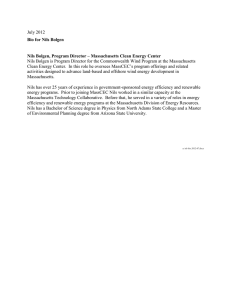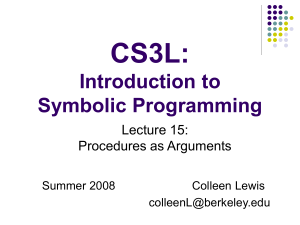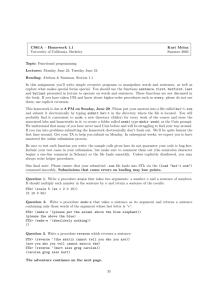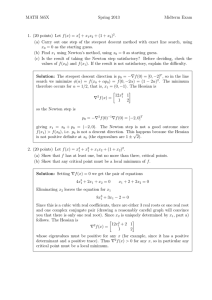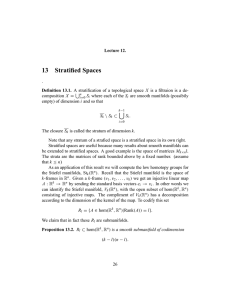Exame STK 2013 with solution
advertisement
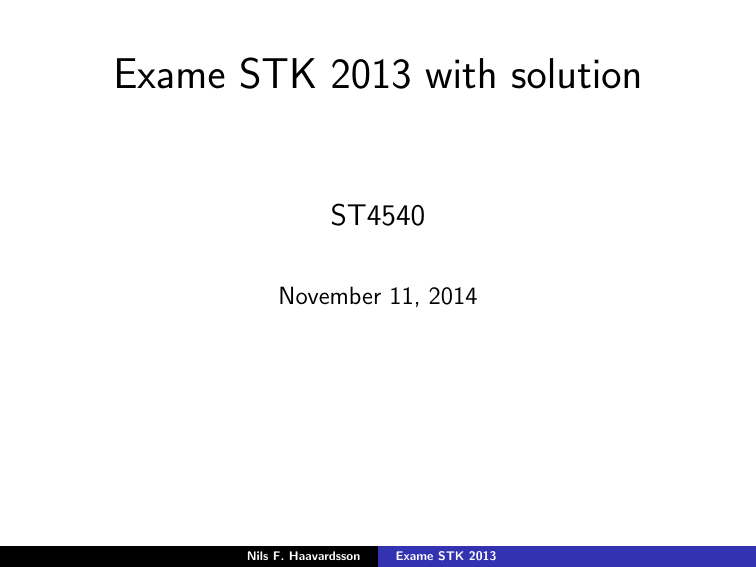
Exame STK 2013 with solution
ST4540
November 11, 2014
Nils F. Haavardsson
Exame STK 2013
Problem 1 a
Assume policy risks X1 , ..., XJ are stochastically independent with
mean and variance for the portfolio payout X being
E (X ) = π1 + ... + πJ and Var(X ) = σ12 + ... + σJ2
where πj = E (Xj ) and σj = sd(Xj ).
a) Use average portfolio expectation and average portfolio
standard deviation to explain the concept of diversification.
Nils F. Haavardsson
Exame STK 2013
(1)
Answer Problem 1a
a) Introduce
π̄ =
1
1
(π1 + ... + πJ ) and σ¯2 = (σ12 + ... + σJ2 )
J
J
(2)
which is the average expectation and variance. Then
¯
√
sd(X )
sigma/π̄
J σ̄ so that
= √
,
E (X )
J
(3)
where the latter is the coefficient of variation, which
approaches zero as J → ∞. Insurance risk can be diversified
away through size.
E (X ) = J π̄ and sd(X ) =
Nils F. Haavardsson
Exame STK 2013
Problem 1 b
b) Does part a) imply that general insurance is risk-free? Justify
your answer.
Nils F. Haavardsson
Exame STK 2013
Solution Problem 1 b
b) The argument of risk diversification does not imply that
general insurance is risk-free, since there is always uncertainty
in underlying models.
I
The predictions of the risk premiums of the different policy
holders applied in pricing may be based on the wrong
assumptions and/or lack of data.
I
Portfolio inflow and outflow may produce shifts in the risk
characteristics of the portfolio that the models do not capture.
I
Furthermore, risks in general insurance may well be dependent
which invalidates the formula for var(X ).
Nils F. Haavardsson
Exame STK 2013
Problem 1 c
c) How can the risk of an insurance company be reduced? Why
would an insurance company be interested in this?
Nils F. Haavardsson
Exame STK 2013
Solution Problem 1 c
c)
I
Reinsurance is a tool in a company’s tool box and represents a
way to reduce required equity.
I
The most obvious way to reduce the risk of an insurance
company would be to buy re-insurance.
I
For insurance companies in their early phases where capital
may be scarce, re-insurance may prove as a viable source of
capital.
I
Furthermore, if an insurance company is a small player in a
large group, for example a bank, management may prefer
stable, predictable results with lower average return in stead
of more volatile returns with higher average return.
Nils F. Haavardsson
Exame STK 2013
Problem 1 d
d) The loss ratio for a portfolio is incurred losses divided by
earned premium. The gross earned premium refers to the
premium which is actually earned over the financial year and
recognised as revenue. This is calculated before the effect of
re-insurance. Similarly the gross incurred losses refers to the
losses which are actually paid out during the financial year
plus changes in loss reserve during the financial year. The
gross incurred losses are also calculated before the effect of
re-insurance. The gross loss ratio is gross incurred losses
divided by gross earned premium. The net earned premium
and net incurred losses are the cedent’s part of gross earned
premium and gross incurred losses. The net loss ratio is net
incurred losses divided by net earned premium.
Nils F. Haavardsson
Exame STK 2013
Problem 1 d
Incurred losses
Earned premium
Gross
1070
1340
Net
850
1095
Table: Incurred losses and earned premium gross and net for an insurance
company.
Nils F. Haavardsson
Exame STK 2013
Solution Problem 1 d
d)
Incurred losses
Earned premium
Loss ratio
Gross
1070
1340
79.9
Net
850
1095
77.6
Table: Incurred losses, earned premium and loss ratio gross and net
for an insurance company.
The difference in loss ratio gross and net tells us that the
cedent would be worse off without the re-insurance. In other
words, the re-insurer improves the result of the cedent.
Nils F. Haavardsson
Exame STK 2013
Problem 2 a
Variable
Intercept
Gear type
Gear type
Driving limit
Driving limit
Driving limit
Driving limit
Driving limit
Driving limit
Driving limit
Value
Manual
Automatic
8 000
12 000
16 000
20 000
25 000
30 000
No limit
Regression estimate
-5.407
0
-0.340
0
0.097
0.116
0.198
0.227
0.308
0.468
standard deviation
0.01
0.005
0.006
0.007
0.008
0.019
0.012
0.019
Table: Regression estimates with standard deviation for a Poisson
regression.
Nils F. Haavardsson
Exame STK 2013
Problem 2 a
The estimates in Table 2 shows the effect of gear type and annual
driving limit on claim intensity in autmobile insurance. Estimates
are from monthly data.
a) Argue that the model applies on annual time scale if the
intercept parameter is changed.
Nils F. Haavardsson
Exame STK 2013
Solution Problem 2 a
I
The claim intensity µ applies per time unit. The effect of gear
type and annual driving limit on claim intensity amounts to
relative changes in µ and will be constant relative to µ if the
exposure time is changed.
I
If the exposure time is changed, the expected number of
claims will be changed.
I
The argument disregards possible seasonal variations in µ, an
assumption that can be justified by letting µ on monthly basis
be estimated based on an average month.
Nils F. Haavardsson
Exame STK 2013
Problem 2 b
b) How much higher is the annual claim intensity for cars with
manual gear?
Nils F. Haavardsson
Exame STK 2013
Solution Problem 2 b
b) The annual claim intensity for cars with manual gear is
exp(0)/exp(−0.34) − 1 = 1/0.71177 − 1 = 40.5% higher than
the annual claim intensity for automatic cars.
Nils F. Haavardsson
Exame STK 2013
Problem 2 c
c) How do you interpret that the driving limit coefficients
increase as the driving limit increases?
Nils F. Haavardsson
Exame STK 2013
Solution Problem 2 c
c)
I
The claim intensity increases as the driving limit increases,
which is natural as the exposure most likely increases as the
driving limit increases.
I
The claim intensity does not increase as much in percent as
the percent increase in driving limit.
I
This may be caused by increased driving skills by drivers with
higher driving limits.
I
Alternatively, or in combination, higher driving limits may be
more associated with longer rides, which may be less exposed
to accidents.
Nils F. Haavardsson
Exame STK 2013
Problem 2 d
d) Use Table 2 to compute annual claim intensities broken down
on gear type and driving limit as shown in Table 3.
Manual gear
Automatic gear
8 000
12 000
16 000
20 000
25 000
30 000
No limit
Table: Annual claim intensities broken down on gear type and
driving limit.
Nils F. Haavardsson
Exame STK 2013
Solution Problem 2 d
8 000
12 000
16 000
20 000
25 000
30 000
No limit
Manual gear
5.38%
5.93%
6.04%
6.56%
6.75%
7.32%
8.59%
Automatic gear
3.83%
4.22%
4.30%
4.67%
4.81%
5.21%
6.12%
Table: Annual claim intensities broken down on gear type and driving
limit.
Nils F. Haavardsson
Exame STK 2013
Problem 2 e
e) Create a new Table from Table 3 by dividing the entries on
the corresponding driving limit and argue that this might be a
rough measure of claim intensity per kilometer.
Nils F. Haavardsson
Exame STK 2013
Solution Problem 2 e
8 000
12 000
16 000
20 000
25 000
30 000
Manual gear
0.00067%
0.00049%
0.00038%
0.00033%
0.00027%
0.00024%
Automatic gear
0.00048%
0.00035%
0.00027%
0.00023%
0.00019%
0.00017%
Table: Annual claim intensities broken down on gear type and driving
limit.
Nils F. Haavardsson
Exame STK 2013
Solution Problem 2 e
If every policy holder utilize the driving limit paid for in the
insurance 100%, the adjusted claim frequency gives a measure of
claim intensity per kilometer. Most likely this is roughly correct,
since the actual distance driven by every policy holder often will
deviate from the driving limit paid for in the insurance. The
assumption states that the deviation is small on average.
Nils F. Haavardsson
Exame STK 2013
Problem 2 f
f) What is the change in pattern from d) to e)? What is the
underlying phenomenon do you think?
Nils F. Haavardsson
Exame STK 2013
Solution Problem 2 f
I
The risk per kilometer decreases as the number of kilometer in
the driving limit increases.
I
This phenomenon may be caused by increased driving skill.
The pattern may also be explained by longer rides which may
be less exposed to accidents.
I
The nature of the rides may be different, more business rides
and less pleasure rides.
I
There may also be that the driving limits increase in the
country side, where there may be other kinds of accidents.
The accidents in the countryside may be less frequent but
with higher impact.
Nils F. Haavardsson
Exame STK 2013
Problem 2 g
Let Tij and nij be total risk exposure and total number of claims
for gear type i and driving limit j, where i = 1, 2 and j = 1, ..., 7.
Assume elementary estimates µ̂ij are given as µ̂ij = nij /Tij and
that they are as presented in Table 4.
Nils F. Haavardsson
Exame STK 2013
Problem 2 g
8 000
12 000
16 000
20 000
25 000
30 000
No limit
Manual gear
5.4%
5.8%
6.3%
6.8%
6.6%
7.0%
8.9%
Automatic gear
3.8%
4.4%
4.3%
4.5%
4.8%
5.0%
6.0%
Table: Elementary estimates broken down on gear type and driving limit.
Nils F. Haavardsson
Exame STK 2013
Problem 2 g
Compare the method of elementary estimates and the Poisson
regression in a)-f) and judge both approaches.
Nils F. Haavardsson
Exame STK 2013
Solution Problem 2 g
g)
I
A cross-tabulation approach with the elementary estimates
with one assessment for each combination of the explanatory
variables might be a good idea if the number of explanatory
variables is low and the number of groups for each explanatory
variable is low and if individuals are quite evenly distributed
for each group.
I
If there are too many groups, easily thousands if the number
of explanatory variables is, say five with five or six groups per
variable, and the individuals are unevenly distributed,
estimates would easily be fraught with random error.
I
Such errors make such estimates unsuitable for pricing.
Regression dampens such randomness.
Nils F. Haavardsson
Exame STK 2013
Problem 3 a
Let X be the sum of claims for a policy holder during a year and
introduce
π(ω) = E (X |ω) and σ(ω) = sd(X |ω)
where ω is an underlying, unknown, random quantity. We seek
π = π(ω), the conditional pure premium of the policy holder as
basis for pricing. On group or portfolio level there is a common ω
that applies to all risks jointly. The target is now Π = E (X |ω)
where X is the sums of claims from many individuals.
Nils F. Haavardsson
Exame STK 2013
Problem 3 a
Let X1 , ..., XK (policy level) or X1 , ..., XK (group level) be
realizations of X or X dating K years back. The standard method
in credibility is the linear one with estimates of π of the form
π̂K = b0 + w X̄K where X̄K = (X1 + ... + XK )/K .
The structural parameters are defined as
π̄ = E {π(ω)}, v 2 = var{π(ω)}, τ 2 = E {σ 2 (ω)}
(4)
where π̄ is the average pure premium for the entire population.
Both v and τ represent variation. Their impact on var (X ) can be
understood through the rule of double variance,
var(X ) = E {var(X |ω)}+varE (X |ω) = E {σ 2 (ω)}+var(π(ω)) = τ 2 +v 2 .
The optimal linear credibility estimate is
π̂K = (1 − w )π̄, where w =
Nils F. Haavardsson
v2
.
v 2 + τ 2 /K
Exame STK 2013
(5)
Problem 3 a
a) Prove that E {X̄K } = E {π(ω)} and that
Var{X̄K } = v 2 + τ 2 /K .
Nils F. Haavardsson
Exame STK 2013
Solution Problem 3 a
a) Proof of E {X̄K } = E {π(ω)}:
E {X̄K |ω} = E {
K
1 ∑
Xj |ω}
K
j=1
=
K
1 ∑
1
E {Xj |ω} = KE {Xj |ω} = π(ω),
K
K
j=1
⇒ E {X̄K } = E {E {X̄K |ω}} = E {π(ω)} = π̄.
Nils F. Haavardsson
Exame STK 2013
Solution Problem 3 a
Proof of Var{X̄K } = v 2 + τ 2 /K :
var{X̄K |ω} = var{
K
1 ∑
Xj |ω}
K
j=1
=
K
1 ∑
1
1
var{Xj |ω} = 2 K var{Xj |ω} = σ 2 (ω),
2
K
K
K
j=1
where the variance of the sum is the sum of the variance of each
variable since X1 , ..., XK given ω are conditionally independent and
identically distributed. It follows that
var{X̄K } = var{E {X̄ |ω}} + E {var(X̄K |ω)} =
var(π(ω)) + E {σ 2 (ω)/K } = v 2 + τ 2 /K .
Nils F. Haavardsson
Exame STK 2013
Problem 3 b
b) Prove that Cov{X̄K , π(ω)} = v 2 . (Hint: Find
E ((X̄K − π̄)(π(ω) − π̄)|ω) and use the definition of covariance
and the rule of double expectation.)
Nils F. Haavardsson
Exame STK 2013
Solution Problem 3 b
b) Proof of Cov{X̄K , π(ω)} = v 2 :
E {(X̄K − π̄)(π(ω) − π̄)|ω} = E {((X̄K − π̄)|ω)(π(ω) − π̄)}
= {π(ω) − π̄}{π(ω) − π̄} = {π(ω) − π̄}2 .
So it follows that
Cov{X̄K , π(ω)} = E {X̄K − π̄}{π(ω) − π̄}
= E {E {X̄K −π̄}{π(ω)−π̄}|ω} = E {π(ω)−π̄}2 = var (π(ω)) = v 2 .
Nils F. Haavardsson
Exame STK 2013
Problem 3 c
c) Prove that w =
Use that
v2
v 2 +τ 2 /K
minimizes Var{π̂K − π(ω)}. (Hint:
Var{π̂K − π(ω)} = Var{b0 + w X̄K − π(ω)}
and use the definition of the variance of the sum of
dependent, random variables.)
Nils F. Haavardsson
Exame STK 2013
(6)
Solution Problem 3 c
c) Proof that w =
v2
v 2 +τ 2 /K
minimizes Var{π̂K − π(ω)}:
var{π̂K − π(ω)} = var{b0 + w X̄K − π(ω)}
= w var(X̄K ) − 2w cov(X̄K , π(ω)) + var{π(ω)},
2
or using (2):
var{π̂K − π(ω)} = w 2 (v 2 + τ 2 /K ) − 2wv 2 + v 2 .
var(π̂K − π(ω)) is minimized with respect to w:
∂
var(π̂K − π(ω)) = 0
∂w
v2
⇔ 2w (v 2 + τ 2 /K ) − 2v 2 = 0 ⇔ w = 2
v + τ 2 /K
Nils F. Haavardsson
Exame STK 2013
Solution Problem 3 c
2
v
It follows that var(π̂K − π(ω)) = 1+Kv
2 /τ 2 . The estimate π̂K is
unbiased and minimizes var{π̂K − π(ω)} which is the same as
minimizing the mean squared error E {π̂K − π(ω)}2 .
Nils F. Haavardsson
Exame STK 2013
Problem 3 d
d) Suppose we seek Π(ω) = E {X |ω} where X is the sum of
claims from a group of policy holders where J denotes the
group size. Now ω represents uncertainty common to the
entire group. and the linear credibility estimate (3) is applied
to the record X1 , ..., XK of that group. The structural
parameters differ from what they were above. If individual
risks are independent given ω, then
√
E {X |ω} = Jπ(ω) and sd{X |ω} = Jσ(ω).
(7)
What do the structural parameters become now?
Nils F. Haavardsson
Exame STK 2013
Solution Problem 3 d
The structural parameters become J π̄, J 2 v 2 and Jτ 2 instead of
π̄, v 2 and τ 2 .
Nils F. Haavardsson
Exame STK 2013
Problem 3 e
e) Use (3) to express the best linear estimate Π̂K and find the
equivalent of w from (3) on group level.
Nils F. Haavardsson
Exame STK 2013
Solution Problem 3 e
It follows since w =
v2
v 2 +τ 2 /K
that
Π̂K = (1 − w )J π̄ + w X̄K where w =
v2
,
v 2 + τ 2 /JK
where X̄K = (X1 + ... + XK )/K is the average claim on group level.
Nils F. Haavardsson
Exame STK 2013
